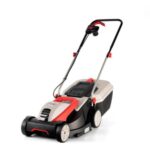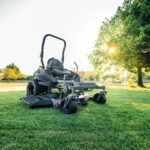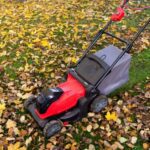As an experienced lawn care professional with over 7 years in the industry, I’m often asked by homeowners how they can best prepare their lawns for the transition from summer to fall. While summer is often focused on promoting growth and vibrancy, fall lawn care is centered around fortifying your grass to withstand colder temperatures and less sunlight. Proper fall lawn preparation can make all the difference in how healthy your yard looks in spring after emerging from dormancy. Read below about “How to Prepare Your Lawn for the Fall Cool Down Season?”.
In this article, I’ll share my top tips and expert advice for getting your lawn ready for the fall cool down based on my extensive experience servicing lawns in this region. As the owner of a reputable lawn care company in the area, I’ve seen firsthand what methods work best for transitioning lawns from summer to fall. My goal is to equip homeowners with the knowledge and action steps required for a seamless seasonal lawn transition.
Table of Contents
Assess Lawn Health and Identify Problem Areas
The first step in fall lawn preparation is assessing the current health of your yard. Walk around your lawn and make note of any problem spots, such as dead patches, weeds, disease, insect damage, or excessive thatch buildup. Check for compaction by pushing a screwdriver into the soil – resistance means the soil is too compacted for proper root development. Examining lawn health will allow you to identify areas needing improvement before cooler weather arrives.
If you notice substantial bare or thin spots, you may need to reseed those areas to establish new grass growth. Make sure to choose a grass seed variety well-suited for fall planting. As a lawn care professional, I recommend perennial ryegrass blends for fall reseeding. The seedlings establish quickly to provide winter ground cover, making for an easy spring transition back to your normal lawn.
Apply Fertilizer Formulated for Fall
Fertilizing is crucial for conditioning your lawn for colder temperatures. Look for fertilizers labeled as a “winterizer” or containing at least 50% slow-release nitrogen. The nitrogen nourishes roots and crowns to promote deep growth before growth naturally slows from cold. Potassium is also important this time of year for increasing disease resistance.
I recommend applying fertilizer around Labor Day, using about 1 pound of nitrogen per 1,000 square feet. Organic options like compost and manure also build soil nutrients for stronger grass plants. Just be sure to spread them early enough before the ground freezes. Proper fall fertilization makes grass more resilient against harsh winter elements.
Raise Your Mowing Height
Let your lawn grow out a bit taller than usual for fall. For cool season grasses, I suggest raising mower height to 3-4 inches. The extra length provides insulation for crowns and roots against cold air and soil temperatures. Longer grass blades also aid in photosynthesis by absorbing more available sunlight.
Make sure not to remove any more than 1/3 of the total blade length when mowing during fall. Taking off too much at once stresses the plant. Gradually increase mowing height over a period of 2-3 weeks until you reach your target length.
Continue Watering if Conditions are Dry
Fall weather is often more sporadic, with stretches of dryness mixed with rainy periods. While you should water less frequently, continue providing supplemental irrigation if weeks pass with little rainfall. Dry soil going into winter will cause grass plants to struggle.
Aim to provide your lawn with about 1-1.5 inches of water per week from either natural rain or irrigation. The specific amount needed depends on your soil type, as sandy soils require more frequent watering than clay. Visually monitor lawn health and water as needed to prevent dormancy. Be sure to account for rainfall by using smart irrigation controllers.
Aerate Compacted Soils
Soil compaction is a common issue that restricts root development, reduces drainage and limits nutrient absorption. Cooler fall temperatures make it an ideal time to aerate and relieve compacted soils. I recommend core aeration, which pulls plugs from the lawn to open up the ground. This allows better movement of air, water and nutrients through the root zone.
For best results, aerate when the lawn is actively growing in early fall. Wet the lawn prior to aerating for easier plug removal. Break up removed cores and leave them to decompose on the lawn. The extra organic matter is beneficial for improving soil structure over time. Enhance the effects by topdressing with compost after aerating.
Overseed Bare or Thin Areas
Fall is the best season for overseeding cool season grasses like fescue and bluegrass. The moderate temperatures and increased moisture create an ideal growing environment for grass seedlings. Take advantage of this window by identifying bare or thin portions of your lawn and spreading new seed in those areas.
Prior to overseeding, mow the existing grass short and remove any debris that could obstruct seed-to-soil contact. Use a slice seeder that cuts into the soil, deposits seed, then presses the seed into the ground. This ensures proper seed coverage and moisture retention. Water gently each day to maintain moist soil until new growth emerges. With proper seeding and care, your new grass should mature enough by winter to resist damage.
Weed and Disease Control
Weeds and lawn diseases get a foothold when grass plants become stressed. Weakened grass allows opportunistic weeds to invade. Excessive moisture, shade, poor drainage and compacted soil are common triggers for diseases like brown patch, dollar spot and gray leaf spot. As a lawn care expert, I’ve seen how weeds and disease can damage an otherwise healthy lawn.
That’s why proactive control is so important during fall. Monitor for early signs of emerging weed and disease issues. Selective herbicides containing 2,4-D or dicamba provide post-emergent control for common lawn weeds. Fungicides labeled for prevention of common lawn diseases can also be applied preventatively in fall. Identify and treat problems early before they escalate over the winter.
Clean Up Fallen Leaves

The inevitable autumn leaf drop brings a fresh layer of organic matter onto lawns. While limited leaf litter can be beneficial, excessive accumulations will block sunlight and promote disease issues like snow mold. I recommend removing fallen leaves at least once per week throughout fall. Use a mulching mower to shred and recycle leaves back into the turf or collect them for composting.
Avoid piling leaves on the lawn for long periods, as it results in dead grass underneath. If leaves accumulate faster than you can remove them, concentrate on high traffic areas. Keeping pathways and play areas clear prevents fallen leaves from smothering the grass. Staying on top of leaf cleanup prevents suffocation damage before winter dormancy.
Schedule a Soil Test
Autumn is an opportune time for soil testing before making spring nutrient adjustments. A soil test determines pH and analyzes essential macro and micronutrients in your lawn such as nitrogen, potassium and iron. The test results reveal precisely which amendments your soil needs for optimal growing conditions.
I recommend testing every 3-5 years to monitor soil changes over time. You can take samples yourself or hire a lawn care company to perform professional testing. Proper soil nutrition sets up your lawn for success coming out of winter dormancy. Adjusting nutrients now based on soil test results will make your spring lawn care regimen more effective.
Trim Bushes and Trees
While not directly related to lawn care, trimming back overgrown trees and bushes will benefit the turf below. Thinning excessive growth on the lower branches of trees and shrubs will allow more sunlight to filter down to your lawn. The additional light exposure is especially helpful in fall to keep grass plants actively photosynthesizing as long as possible before winter.
Also, pruning evergreen shrubs now reduces the load of fallen needles come spring. Clearing heavy debris buildup makes spring lawn maintenance much simpler. As light and temperatures decrease, diligent fall pruning sets up your landscaping for better health next growing season.
Conclusion
In summary, the main steps for proper fall lawn preparation include:
- Assessing lawn health and addressing problem areas
- Fertilizing with formulations containing nitrogen and potassium
- Raising mowing height for insulation against cold
- Watering during dry periods to prevent dormancy
- Aerating compacted areas
- Overseeding bare or thin spots
- Controlling emerging weeds and disease
- Removing fallen leaves regularly
- Conducting a soil test and making amendments
- Pruning trees and shrubs for optimal light exposure
By taking these proactive measures in fall, you can send your lawn into winter dormancy in peak health. Addressing issues now curtails further problems next spring. Your diligent fall preparation will pay dividends later through a lush, vigorous lawn that thrives after the winter chill. Implementing my tips and expertise will ensure your yard transitions seamlessly from summer to fall. Let me know if you have any other questions! I’m always happy to share my experience as a lawn care specialist.

Barry, the expert behind LawnInspection.com, holds a Master’s degree in Horticulture and brings over 20+ years of hands-on experience in landscaping and lawn care. With certifications in sustainable lawn management, Barry is dedicated to providing readers with authoritative insights and practical tips for maintaining lush, healthy lawns. His extensive knowledge and commitment to excellence ensure that every piece of advice on LawnInspection.com helps transform your lawn into a green oasis with proven, eco-friendly practices. Connect with Barry on social media: Instagram and Facebook.









